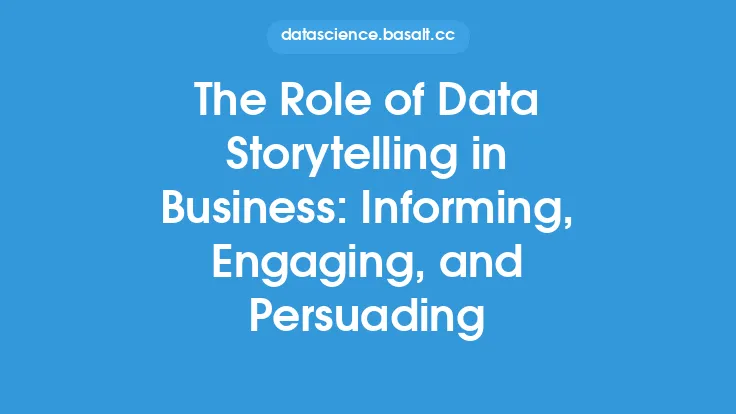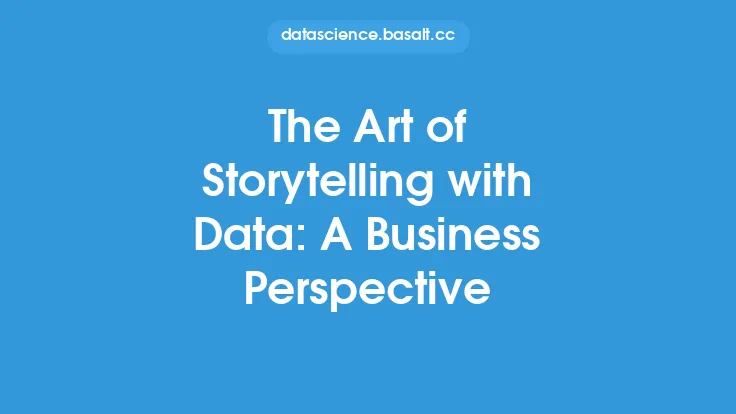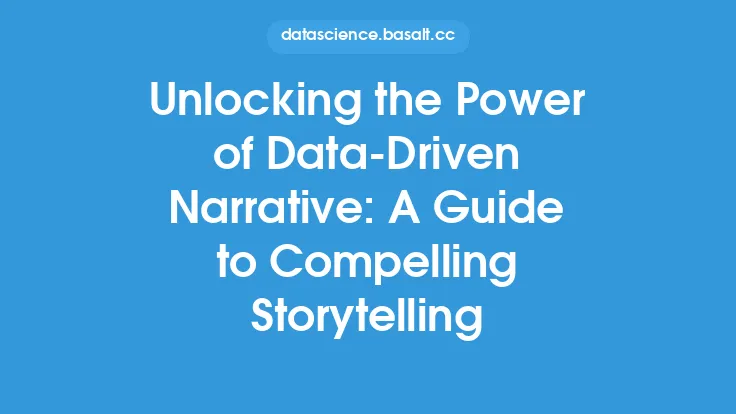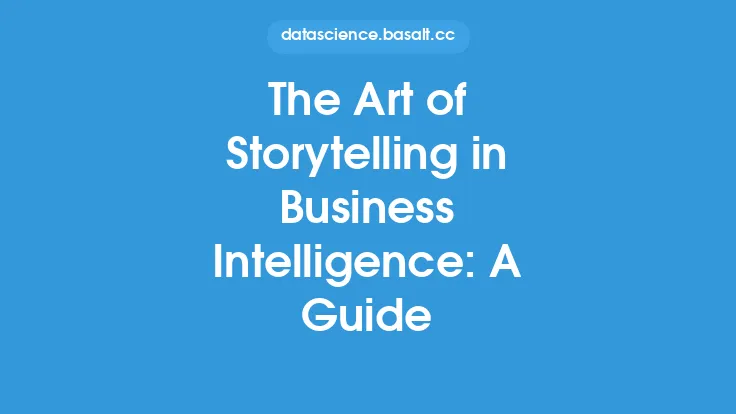In today's fast-paced and competitive business landscape, organizations are constantly seeking ways to gain a competitive edge and make informed strategic decisions. One key aspect that has emerged as a crucial factor in achieving this goal is the effective use of data storytelling. Data storytelling is the process of using data to tell a story that informs, engages, and persuades stakeholders, driving business outcomes and strategic decision-making. At its core, data storytelling is about presenting complex data insights in a clear, concise, and compelling manner, making it easier for business leaders to understand and act upon the information.
Introduction to Data Storytelling
Data storytelling is a multidisciplinary field that combines data analysis, visualization, and narrative techniques to communicate insights and trends in data. It involves using data to identify key trends, patterns, and correlations, and then presenting this information in a way that is easy to understand and act upon. Effective data storytelling requires a deep understanding of the business, its goals, and its challenges, as well as the ability to communicate complex technical information in a clear and concise manner. By leveraging data storytelling, businesses can unlock the full potential of their data, driving better decision-making, improved operational efficiency, and increased competitiveness.
The Benefits of Data Storytelling
The benefits of data storytelling are numerous and well-documented. By using data storytelling, businesses can gain a deeper understanding of their customers, markets, and operations, driving better decision-making and strategic planning. Data storytelling can also help to identify areas of inefficiency and waste, enabling businesses to optimize their operations and improve their bottom line. Additionally, data storytelling can be used to communicate complex technical information to non-technical stakeholders, facilitating collaboration and driving business outcomes. Some of the key benefits of data storytelling include:
- Improved decision-making: Data storytelling provides business leaders with the insights and information they need to make informed strategic decisions.
- Increased operational efficiency: Data storytelling can help businesses identify areas of inefficiency and waste, enabling them to optimize their operations and improve their bottom line.
- Enhanced customer understanding: Data storytelling can provide businesses with a deeper understanding of their customers, enabling them to develop more effective marketing strategies and improve customer engagement.
- Better communication: Data storytelling can help to communicate complex technical information to non-technical stakeholders, facilitating collaboration and driving business outcomes.
The Process of Data Storytelling
The process of data storytelling involves several key steps, including data collection, data analysis, data visualization, and narrative development. The first step in the data storytelling process is data collection, which involves gathering and integrating data from various sources. This data is then analyzed to identify key trends, patterns, and correlations, using techniques such as statistical modeling, data mining, and machine learning. The insights and findings from the data analysis are then visualized using a range of techniques, including charts, graphs, and maps. Finally, a narrative is developed to communicate the insights and findings, using storytelling techniques such as character development, plot structure, and conflict resolution.
Data Visualization in Data Storytelling
Data visualization is a critical component of data storytelling, providing a powerful way to communicate complex data insights in a clear and concise manner. Effective data visualization involves using a range of techniques, including charts, graphs, and maps, to present data in a way that is easy to understand and interpret. Some of the key principles of effective data visualization include:
- Clarity: The visualization should be clear and easy to understand, avoiding unnecessary complexity and clutter.
- Simplicity: The visualization should be simple and concise, focusing on the key insights and findings.
- Consistency: The visualization should be consistent in terms of color, font, and layout, making it easy to compare and contrast different data points.
- Interactivity: The visualization should be interactive, enabling users to explore and analyze the data in more detail.
Narrative Development in Data Storytelling
Narrative development is a critical component of data storytelling, providing a powerful way to communicate complex data insights in a clear and compelling manner. Effective narrative development involves using storytelling techniques such as character development, plot structure, and conflict resolution to create a narrative that is engaging, informative, and persuasive. Some of the key principles of effective narrative development include:
- Character development: The narrative should have a clear protagonist, such as a customer or a business, and a clear antagonist, such as a challenge or a competitor.
- Plot structure: The narrative should have a clear beginning, middle, and end, with a clear structure and flow.
- Conflict resolution: The narrative should have a clear conflict or challenge, and a clear resolution or outcome.
- Emotional connection: The narrative should create an emotional connection with the audience, using techniques such as empathy, humor, and surprise.
Technical Skills for Data Storytelling
Data storytelling requires a range of technical skills, including data analysis, data visualization, and programming. Some of the key technical skills for data storytelling include:
- Data analysis: This involves using techniques such as statistical modeling, data mining, and machine learning to analyze and interpret data.
- Data visualization: This involves using tools such as Tableau, Power BI, and D3.js to create interactive and dynamic visualizations.
- Programming: This involves using languages such as Python, R, and SQL to collect, analyze, and visualize data.
- Data management: This involves using techniques such as data warehousing, data governance, and data quality to manage and maintain large datasets.
Best Practices for Data Storytelling
There are several best practices for data storytelling, including:
- Keep it simple: The narrative should be simple and concise, focusing on the key insights and findings.
- Use interactive visualizations: Interactive visualizations can help to engage and persuade the audience, enabling them to explore and analyze the data in more detail.
- Use storytelling techniques: Storytelling techniques such as character development, plot structure, and conflict resolution can help to create a narrative that is engaging, informative, and persuasive.
- Use clear and concise language: The language should be clear and concise, avoiding technical jargon and complex terminology.
- Use emotional connection: The narrative should create an emotional connection with the audience, using techniques such as empathy, humor, and surprise.
Common Challenges in Data Storytelling
There are several common challenges in data storytelling, including:
- Data quality: Poor data quality can make it difficult to analyze and interpret the data, leading to inaccurate or misleading insights.
- Data complexity: Complex data can be difficult to analyze and visualize, requiring specialized skills and techniques.
- Stakeholder engagement: Stakeholders may not be engaged or interested in the data, requiring effective communication and storytelling techniques to persuade and inform.
- Technical skills: Data storytelling requires a range of technical skills, including data analysis, data visualization, and programming.
- Time and resources: Data storytelling can be time-consuming and resource-intensive, requiring significant investment and commitment.
Conclusion
Data storytelling is a powerful tool for businesses, providing a way to communicate complex data insights in a clear and compelling manner. By leveraging data storytelling, businesses can gain a deeper understanding of their customers, markets, and operations, driving better decision-making and strategic planning. Effective data storytelling requires a range of technical skills, including data analysis, data visualization, and programming, as well as storytelling techniques such as character development, plot structure, and conflict resolution. By following best practices and avoiding common challenges, businesses can unlock the full potential of their data, driving business outcomes and strategic decision-making.





